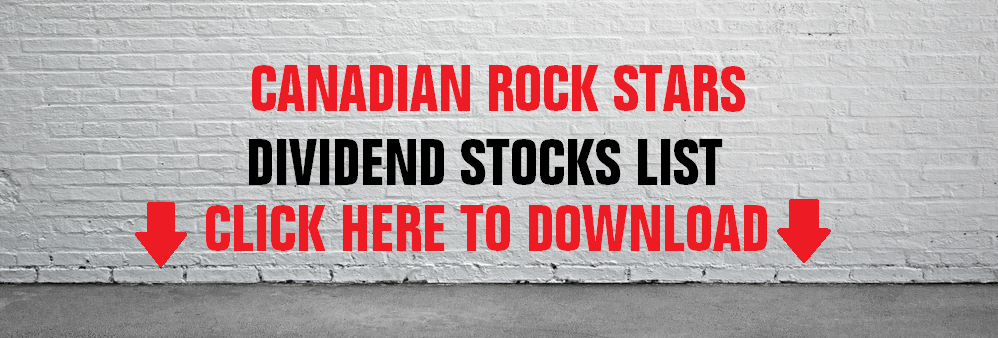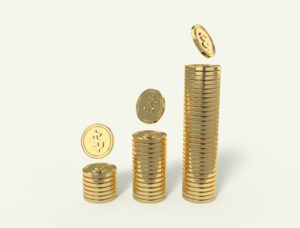Having a cash reserve on-hand makes it easier to transition from your investment accumulation years to your retirement years and protects your portfolio during times of volatility.
 Throughout your retirement, you’ll go through bull and bear markets. During a bear market, selling shares to generate your homemade dividend could hurt your retirement plan.
Throughout your retirement, you’ll go through bull and bear markets. During a bear market, selling shares to generate your homemade dividend could hurt your retirement plan.
That’s when the cash reserve helps; it’s money that is not invested in the stock market anymore. It must be secure and easily accessible.
How to use the cash reserve
Your cash reserve bridges the gap between what your portfolio generates in dividends and your retirement budget; it prevents having to sell shares when it is not advantageous to do so.
If you need $50,000 per year and your portfolio generates $40,000, the gap is $10,000 per year.
The $10,000 gap could be filled by selling shares. Selling shares at a depreciated value could hurt your retirement, whereas dipping into a cash reserve keeps your portfolio intact. When the market recovers, you can sell additional shares to refill your cash reserve.
How much cash reserve is enough?
There’s no clear answer to this question. You want to mitigate the impact of market volatility on your withdrawal sequence, but you also want to maximize your portfolio returns.
A large cash reserve increases the short-term protection of your withdrawals but amputates your portfolio’s ability to generate higher returns on the market over the long haul.
Therefore, the amount of the cash reserve depends on the gap to fill and your tolerance to volatility. Some investors are comfortable without any cash reserve; they simply accept that they will sell shares yearly to complete their retirement budget, regardless of how the market is doing.
Others prefer a large cash reserve to cover all potential catastrophes. While most bear markets take around 24 months to recover, some have taken more than four years to fully recover.
Get some great stock ideas to build your portfolio and cash reserve with our Rock Stars List

DOWNLOAD THE LIST HERE
Create a cash reserve
To create a cash reserve, you can stop reinvesting your dividends a few years before retiring and let the cash build up in your account. It’s on autopilot, simple, but it could take a few years to reach the required amount; during that time, the cash doesn’t generate any meaningful returns.
To let your portfolio work at full speed until the very last moment, you could sell one- or two-years’ worth of your financial needs in shares on day 1 of your retirement. However, if you retire at the bottom of the market, you’d be selling at a very bad time.
Cash reserve example
Imagine you have a $1M portfolio, an average dividend yield of 3.5%, and a retirement budget of $50,000/year. Since the portfolio generates $35,000 in dividends ($1M X 3.5%), the gap between what you generate and what you need is $15,000.
To ensure you don’t have to sell shares during a bad year, you decide to create a cash reserve of four years’ worth of the $15,000 gap, so $60,000.
Create and manage the cash reserve
In this example, a few years before start of your retirement, you stop reinvesting your dividends to let them accumulate. A year before your retirement date, you have your $60,000 cash reserve on hand.
You manage your cash reserve through a three-year ladder of Guaranteed Investment Certificates (GICs), Certificates of Deposit (CD), and/or bonds that would look something like this:
 $20,000 for 1 year at 3%
$20,000 for 1 year at 3%- $20,000 for 2 years at 3.25%
- $20,000 for 3 years at 3.30%
You also keep accumulating your dividends in cash rather than reinvesting them.
At the end of the year, you retire
As you retire, your 1-year GIC/CD is worth $20,000 + $600 (one year of interest). Since you stopped reinvesting your dividends 12 months ago, you’ve also accumulated $35,000 in dividends ($1M X 3.5%).
Income on hand for year 1 of retirement
| GIC/CD with interest | $20,600 |
| Dividends | + $35,000 |
| Total | $55,600 |
| Budget | ($50,000) |
| Difference | + $5,600 |
You reinvest that extra $5,600 for another 3 years to feed the ladder and keep it going.
If it’s a good year and your portfolio is up, you sell shares to have just enough money to “refill” your bond ladder. Then you have another $20K to invest for 3 years. With the extra $5,600 on hand, you only have to sell $14,400 of shares to reach $20K and complete the ladder.
Notice that $14.4K on $1M equals a 1.44% capital gain. On most years, you’ll be able to do that easily without chipping away at your capital.
What if the market is bad?
If it’s not a good year and your portfolio is down, you can easily wait 6 months or a year and see where the market is at that time before selling shares. Really? Yes, because you already have your income for the year and, at the end of year 1, you’ll have this on hand for year 2 of retirement:
| 2-year GIC/CD with 3.25% interest | $21,321 |
| One year of dividends* | + $35,000 |
| Total | $56,321 |
| Budget | ($50,000) |
| Difference | + $6,321 |
* This is the same amount as the previous year; by investing in dividend growers, it is likely that some of your holdings increased their dividends, so this could be higher.
If at the end of year 2 of retirement the market is still bad, you still have your 3-year GIC/CD worth $22,046, and another 12 months of dividends from your portfolio.
Of course, waiting to sell shares during a bad spell in the market means that eventually you’ll have to sell more to refill your cash reserve ladder.

Considering that most crashes happen over a few months or a year, after which the market starts recovering, and that the cash reserve ladder ensures you have over two years of buffer, you’ll be in a good position to refill the ladder using only or mostly your capital gains and dividend increases, thus securing your retirement for year to come!